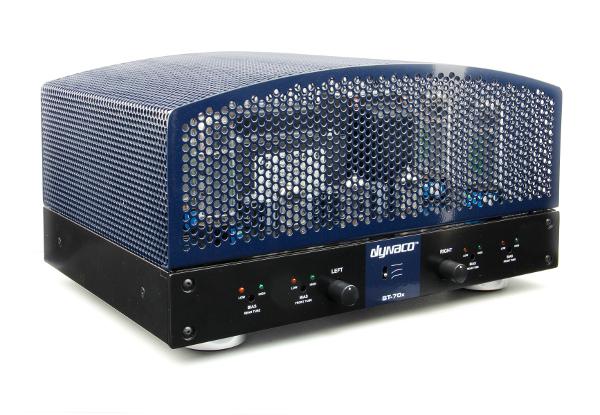Congratulations to Radial Engineering of Canada for bringing Dynaco back for a third generation ST70. I did the same in 1993, reviving the brand and starting with the ST70 II and PAS 3 Mk II among other models. Panor
Corp of Long Island, NY was my backer, we did a good job with these products but after my departure in '95 the brand lost steam again.
Radial seems to have the necessary passion to do this right, I wish them and my favorite old time brand great success in the future. Nice job!
Return of the Iconic Dynaco ST70 Tube Amp

Radial plans to deliver the ST70 Series 3 in January at an estimated retail price of $2,500.
On the return of the ST70, Radial’s senior engineer Dan Fraser had this to say:
In fact, there are tens of thousands of the original Dynaco tube amplifiers still in use around the world. The original Dynaco Stereo 70 is a true classic that is still regarded with awe by audio enthusiasts worldwide. The ST70 Series 3 marks the introduction of a third generation of vacuum tube products bearing the Dynaco name. This "new 70" reflects the illustrious history of Dynaco's involvement with vacuum tube designs as well as the latest advances in vacuum tube technology. We like to think of the Series 3 as the update that David Hafler would have made if he were alive today.Through its long history, the Stereo 70 has proven to be a robust, reliable design of exceptional value. We have sought to preserve the considerable virtues of the original 70 while making fullest use of much better and more modern parts, plus advanced circuit design techniques. When comparing "old 70" with "new 70," one cannot help but notice the external similarity (i.e., the metalwork is of similar dimensions but with an entirely new connector array and top cover). Internally, however, the two units differ radically from each other in both general appearance and execution of design.
The updated amplifier is follows the design of the original 70: The same tried-and-true EL34 and 6CA7 tubes are used, the Pentode-Triode gain circuitry is virtually the same as the original, keeping the signal path as short as practical, and low open-loop gain architecture is maintained in an effort to minimize Transient Intermodulation Distortion (TIM), which is widely regarded as the type of distortion to which the ear is most sensitive.
David Hafler's original output transformer designs have been retained, yet updated with the latest knowledge in the art of winding output transformers, which is said to improve the transient response and allows 4- and 8-ohm operation via a switch.
The new ST70 makes extensive use of the modern parts, including precision metal-film resistors, poly-composition capacitors, and miniaturized high-capacity power supply electrolytics (unavailable at the time of the original design). All signal connectors are gold-plated and the speaker connections are no-touch binding posts compliant with modern safety standards.
Radial says newer parts are more conservatively rated than some of the original parts and, to comply with modern-day practices, a heavy-duty three-pin detachable grounded power cord is provided. Signal ground is the same as electrical ground and chassis.
The printed circuit board material of the original ST70, which deteriorated with age, has been replaced with military-grade, double-sided epoxy fiberglass PC material and nearly two-thirds of trouble-prone original point-to-point wiring has been eliminated.
The bias adjustment is now done with indicator LEDs. After a warm-up period, and with no signal playing, all that is required is to set a pair of LEDs to equal brightness. To accommodate unequal aging between initially matched pairs of output tubes, separate adjustments are provided for both tubes of each pair.
The original ST70's power supply has long been the design area most vulnerable to legitimate criticism. Radial has done the following to address the problem:
• Use a new, larger dual primary power transformer with improved line regulation (due to added iron in its core); it can now be wired for 220 volt / 50 Hz operation.
• The original 5AR4 tube has been replaced by solid-state rectifiers, thus removing the 5AR4's inherent losses and reduced regulation, while eliminating a failure-prone out-of-production tube in the process.
• The original power supply filter capacitance has been increased.
• The troublesome selenium rectifier used in the bias circuitry has also been replaced by a solid-state rectifier with additional supply capacitance.
• The filter inductor has been reduced in value to complement the increase in filter capacitance with a resulting reduction of DC resistance. This provides more voltage for use by the outputs and somewhat higher peak power output.
All of the noted changes serve to improve "stiffness" of the power supply by lowering the effective power supply impedance and improving regulation while increasing available voltage for maximum safe power output, according to Radial, all of which results in a “tighter bottom end.”
The original ST70 design made use of roll-offs within the active circuitry to tailor the frequency response of the amplifier—reducing open-loop gain at the frequency extremes. This open-loop gain reduction resulted in the characteristic distortion increase at the frequency extremes in the original design. Extensive testing and analysis has revealed that roll-offs may not be the most appropriate form of response limiting.
The updated ST70 has an input frequency-limiting filter network to limit bandwidth to 20 to 20,000 Hz. This filter allows the removal of the tailoring components within the active circuitry and permits the active gain circuitry to be flatter across the frequency spectrum. Radial says the audible benefit is an improvement in distortion components at the frequency extremes while still maintaining adequate bandwidth. A high-pass, 3-position filter switch has also been added.
For more information, visit hafler.com.
- Log in or register to post comments


























































